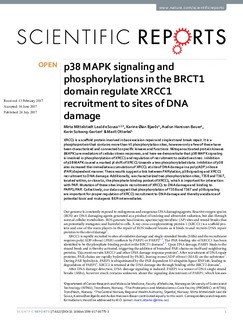| dc.contributor.author | Sousa, Mirta | |
| dc.contributor.author | Bjørås, Karine | |
| dc.contributor.author | Hanssen-Bauer, Audun | |
| dc.contributor.author | Solvang-Garten, Karin | |
| dc.contributor.author | Otterlei, Marit | |
| dc.date.accessioned | 2018-06-20T08:07:16Z | |
| dc.date.available | 2018-06-20T08:07:16Z | |
| dc.date.created | 2017-09-18T10:14:07Z | |
| dc.date.issued | 2017 | |
| dc.identifier.citation | Scientific Reports. 2017, 7(1). | nb_NO |
| dc.identifier.issn | 2045-2322 | |
| dc.identifier.uri | http://hdl.handle.net/11250/2502222 | |
| dc.description.abstract | XRCC1 is a scaffold protein involved in base excision repair and single strand break repair. It is a phosphoprotein that contains more than 45 phosphorylation sites, however only a few of these have been characterized and connected to specific kinases and functions. Mitogen activated protein kinases (MAPK) are mediators of cellular stress responses, and here we demonstrate that p38 MAPK signaling is involved in phosphorylation of XRCC1 and regulation of recruitment to oxidative stress. Inhibition of p38 MAPK caused a marked pI shift of XRCC1 towards a less phosphorylated state. Inhibition of p38 also increased the immediate accumulation of XRCC1 at site of DNA damage in a poly(ADP)-ribose (PAR) dependent manner. These results suggest a link between PARylation, p38 signaling and XRCC1 recruitment to DNA damage. Additionally, we characterized two phosphorylation sites, T358 and T367, located within, or close to, the phosphate-binding pocket of XRCC1, which is important for interaction with PAR. Mutation of these sites impairs recruitment of XRCC1 to DNA damage and binding to PARP1/PAR. Collectively, our data suggest that phosphorylation of T358 and T367 and p38 signaling are important for proper regulation of XRCC1 recruitment to DNA damage and thereby avoidance of potential toxic and mutagenic BER-intermediates. | nb_NO |
| dc.language.iso | eng | nb_NO |
| dc.publisher | Springer Nature | nb_NO |
| dc.rights | Navngivelse 4.0 Internasjonal | * |
| dc.rights.uri | http://creativecommons.org/licenses/by/4.0/deed.no | * |
| dc.title | P38 MAPK signaling and phosphorylations in the BRCT1 domain regulate XRCC1 recruitment to sites of DNA damage | nb_NO |
| dc.type | Journal article | nb_NO |
| dc.type | Peer reviewed | nb_NO |
| dc.description.version | publishedVersion | nb_NO |
| dc.source.volume | 7 | nb_NO |
| dc.source.journal | Scientific Reports | nb_NO |
| dc.source.issue | 1 | nb_NO |
| dc.identifier.doi | 10.1038/s41598-017-06770-3 | |
| dc.identifier.cristin | 1494642 | |
| dc.description.localcode | © The Author(s). Open Access This article is licensed under a Creative Commons Attribution 4.0 International License, which permits use, sharing, adaptation, distribution and reproduction in any medium or format, as long as you give appropriate credit to the original author(s) and the source, provide a link to the Creative Commons license, and indicate if changes were made. The images or other third party material in this article are included in the article’s Creative Commons license, unless indicated otherwise in a credit line to the material. If material is not included in the article’s Creative Commons license and your intended use is not permitted by statutory regulation or exceeds the permitted use, you will need to obtain permission directly from the copyright holder. To view a copy of this license, visit http://creativecommons.org/licenses/by/4.0/. | nb_NO |
| cristin.unitcode | 194,65,15,0 | |
| cristin.unitname | Institutt for klinisk og molekylær medisin | |
| cristin.ispublished | true | |
| cristin.fulltext | original | |
| cristin.qualitycode | 1 | |

